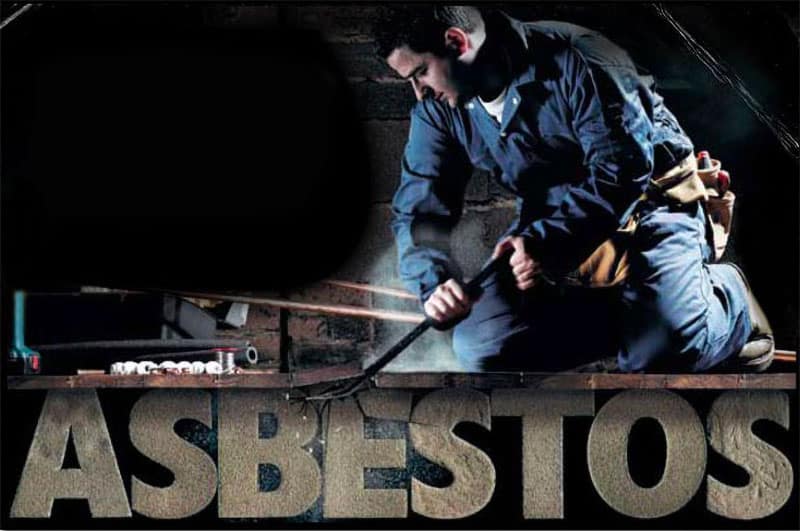Who is at risk of asbestos exposure?
Due to its insulation and fireproofing properties, asbestos was widely used before its negative health effects became understood. While it was banned in the UK in 1999, it can still be found in buildings constructed before 2000.
Common areas and materials that contain asbestos include:
- Acoustic ceilings
- Ceiling and wall insulation
- Cement
- Furnace insulation
- Home appliances
- Patching compounds
- Pipe insulation
- Roofing shingles and siding
- Stove insulation
- Textured paint
- Vinyl flooring
Asbestos may also be present in fire-retardant clothing and vehicle brake pads.

Occupational asbestos risk refers to job positions that have a higher chance of coming into contact with asbestos. Knowing who is at the highest risk of asbestos exposure is a necessary step in order to keep them safe. Professions that are most likely to come into contact with asbestos-containing materials (ACMs) and dangerous asbestos fibres include those in the automotive, construction, and emergency-response fields.
What are the long-term health risks of asbestos exposure?
When asbestos fibres are ingested, they can adhere to the lungs and cause inflammation, scarring, and other respiratory issues. While the body may naturally rid itself of some asbestos fibres, they’re impossible to remove otherwise.
When there’s a buildup of asbestos fibres in a person’s lungs, it can cause life-threatening diseases. The health effects may not show up for several years or decades. Common asbestos-related health conditions include:
- Asbestosis: This is when the lung tissue gets inflamed and scarring. The most common side effect is difficulty breathing.
- Mesothelioma: A rare type of malignant cancer that develops in the abdomen or lungs.
- Other Cancers: Lung cancer, ovarian cancer, and laryngeal cancer can all result from asbestos exposure.
Asbestos can also cause painful inflammation and thickening of the lung lining, which causes respiratory issues.
There is no type of asbestos exposure event that’s considered safe. However, people who work in high-risk settings are more likely to have adverse health effects later in life. The longer a person is exposed to asbestos fibres and the more fibres they ingest, the higher the health risks.
What job roles are most at risk of asbestos exposure?
While any job can occur in a building or area with ACMs, some job roles are more at risk of exposure than others. Workers who regularly handle or run the risk of disturbing asbestos have to be especially diligent when protecting themselves from harmful asbestos fibres. These jobs include:
- Construction workers
- Firefighters
- Industrial workers
- Power plant employees
- Shipyard workers
When it comes to construction workers, practically any role has a high risk of asbestos exposure, including those who work in demolition, builders, electricians, and plumbers, as well as general contractors and other more specified roles.
Why are these workers at risk?
Because workers in these roles have to work directly with materials that may or do contain asbestos, they’re more likely to damage or disturb the asbestos in a way that releases fibres. Undamaged asbestos doesn’t pose a risk when it’s in good condition. However, if something happens to disturb the ACMs, undetectable asbestos fibres can go airborne, and anyone in the vicinity can inhale or swallow them without realising it.
While asbestos hasn’t been used in construction materials since before 2000, buildings that were built before then have a high likelihood of containing the material. Asbestos was so effective and inexpensive that it was used for numerous reasons to provide insulation and fireproofing.
Since it wasn’t yet known to be dangerous, it was used in common ways and also not-so-common ways. Also, since any existing ACMs have been around for over 23 years, it’s very likely they could be damaged or have broken down over time due to normal wear and tear.
Job roles that require working with or around damaged asbestos or performing a duty that could damage asbestos are all high-risk. Demolishing, renovating, and repairing buildings fall into this category.
What are some unexpected ways that asbestos exposure can occur?
It’s clear that if a worker has to demolish ACMs or handle asbestos to remove it from a building, they have to take precautions to stay safe. However, there are several job duties that can result in asbestos exposure even if you assume there’s nothing to worry about. Here are a few examples:
- Eradicating mold in a building. This can mean working directly with ceilings, flooring, or walls that contain asbestos.
- Power-washing roof shingles. If the shingles contain asbestos, power washing can damage the materials. This can lead to asbestos contamination and, once the shingles are dry, the release of asbestos fibres.
- Removing appliances from an old building. Any appliances that pre-date 2000 and that could possibly catch on fire may contain asbestos. These include dishwashers, laundry machines, ovens, and stoves.
Moreover, workers who are around asbestos can bring the fibres into their homes if they don’t change their clothes and properly clean up before leaving the job site. Asbestos fibres can stick to clothing, hair, and even skin. This can lead to contaminating the house and exposing others to the dangerous fibres.
What common areas can asbestos can be found?
Asbestos can be found in several parts of a building or site that was constructed prior to 2000. Let’s go over some of the most common places where asbestos can be found based on the property type.
Asbestos in the home
- Adhesives, such as ones used for flooring
- Backs of vinyl sheet flooring
- Coal and oil furnaces
- Door gaskets
- Hot water and steam pipes
- Older appliances of all sizes (from ironing boards to ovens)
- Paint
- Roofing
- Vinyl floor tiles
Asbestos in healthcare settings
- Ceiling tiles
- Cooling towers
- Electrical wiring
- Floor tiles
- HVAC insulation
- Pipe insulation
- Siding
- Spackling compounds
- Wallboards
Asbestos in schools
- Boiler insulation
- Ceiling tiles
- Cement sheeting
- Ductwork
- Pipe wrapping
- Textured paint (like popcorn ceilings)
- Vinyl flooring, backings, and glue
- Wallboards
Asbestos in industrial settings
- Ceiling tiles
- Cement gutters and downpipes
- Cement water tanks
- Laggings on boilers and pipes
- Loose-fill insulation in crawl spaces, wall cavities, etc.
- Roof panels
- Spray coatings
- Toilet seats
- Windowsills
What are some protective measures you can take against asbestos?
The best defence against asbestos exposure is to be asbestos aware, beginning with taking the appropriate training courses. It’s also wise to familiarise yourself the basics of identifying ACMs. That includes the following:
- Find out when the building was constructed. If it was before 2000, chances are good that asbestos is present.
- Find out when renovations occurred. If some parts of the building were renovated post-2000, they may no longer contain asbestos.
- Know where ACMs are commonly found in your specific type of building and the different areas of that building.
- Consider the texture of the material. Ceilings and walls with a popcorn-like texture typically contain asbestos. Also, asbestos tends to cause dimpling in materials like insulation, roofing, and shingles.
- Check the labels on surplus items. For example, if there are boxes of extra vinyl tiles in the building, the label may say that the items contain asbestos. You’ll then know that the building’s tiles are ACMs.
You can’t usually look at a material and know whether or not it contains asbestos. However, knowing the visual clues of asbestos can help you determine if the material may contain it. When in doubt, always assume that a material has asbestos. That way, you won’t disturb it and create a health risk if it does.
The safest option is to hire a professional who knows exactly where to look and what to look for. They’ll be able to identify and test ACMs, and they can communicate with you about the risks posed and steps to keep the property safe.
Final thoughts about occupational asbestos exposure
While the Health and Safety Executive and the Control of Asbestos Regulations 2012 have guidelines in place to reduce occupational exposure to asbestos, there’s still a degree of risk for people in certain roles. For example, builders and demolition crews are among the highest-risk professions for asbestos exposure.
It’s important to know that there isn’t a routine medical test that can find out if a person’s been exposed to asbestos. Chest X-rays and lung function tests may eventually show that lung damage has occurred. However, the damage done to the lungs may not show up for decades. At that point, it could be too late to reduce the health effects of asbestos exposure.
(If you already have lung damage due to asbestos exposure, you’ll want to speak with a specialist about your health plan moving forward.)
The best prevention is to follow safety practices and legal guidelines when working with or around asbestos. This includes wearing the correct protective and respiratory equipment, properly handling and disposing of ACMs, and fully cleaning and de-contaminating a work area.
Asbestos workers are responsible for their own health and should take asbestos exposure seriously. By educating yourself or your team, you can prevent life-threatening health conditions from occurring later in life.
At Oracle Solutions, we have asbestos management and training solutions so that you can confidently work with and around asbestos-containing materials. Contact us today to speak with an asbestos professional and learn about your options.

Written by Mark Carter
Mark Carter is a renowned expert in asbestos management, offering clients vital guidance on compliance and safety. His expertise is invaluable for navigating asbestos regulations, ensuring both safety and legal adherence. Mark's role is central in providing effective asbestos-related solutions, helping clients achieve their business objectives with an emphasis on regulatory compliance and safety in asbestos management.
